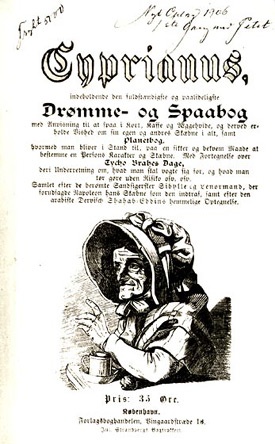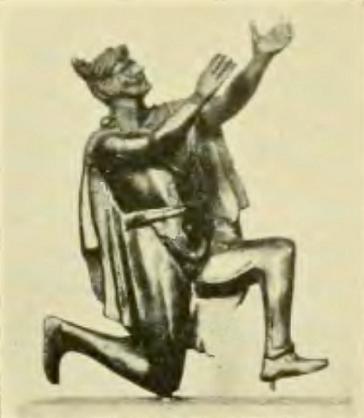|
Cyprianus
''Cyprianus'' is a name given in Scandinavian traditions of folk magic to the "black book" ("''Svarteboken"''): a grimoire or manuscript collection of spells; and by extension to the magical tradition that these spells form a part of. There is no standard text called "Cyprianus"; it was a general label given to a collection of spells. Manuscripts called or referring to Cyprianus had a dark reputation; in some versions, one obtained the text by renouncing one's baptism and devoting oneself to Satan. The common people's opinion of the book was that it was a standard grimoire concerned with the summoning of demons and spirits. Ministers were often thought to have obtained it through their studies at university; it is not coincidence that ministers' wives often functioned as folk healers in rural communities. Like many such texts, it was said to be bound to its owner and hard to get rid of; it was claimed that these texts will not burn nor be destroyed by water, and attempting ... [...More Info...] [...Related Items...] OR: [Wikipedia] [Google] [Baidu] |
Grimoire
A grimoire () (also known as a book of spells, magic book, or a spellbook) is a textbook of magic, typically including instructions on how to create magical objects like talismans and amulets, how to perform magical spells, charms, and divination, and how to summon or invoke supernatural entities such as angels, spirits, deities, and demons. In many cases, the books themselves are believed to be imbued with magical powers. The only contents found in a grimoire would be information on spells, rituals, the preparation of magical tools, and lists of ingredients and their magical correspondences. In this manner, while all ''books on magic'' could be thought of as grimoires, not all ''magical books'' should be thought of as grimoires. While the term ''grimoire'' is originally European—and many Europeans throughout history, particularly ceremonial magicians and cunning folk, have used grimoires—the historian Owen Davies has noted that similar books can be found all around ... [...More Info...] [...Related Items...] OR: [Wikipedia] [Google] [Baidu] |
Cunning Folk
Cunning folk, also known as folk healers or wise folk, were practitioners of folk medicine, White magic, helpful folk magic and divination in Europe from the Middle Ages until the 20th century. Their practices were known as the cunning craft. Their services also included thwarting witchcraft. Although some cunning folk were denounced as witches themselves, they made up a minority of those accused, and the commoner, common people generally made a distinction between the two. The name 'cunning folk' originally referred to Cunning folk in Britain, folk-healers and magic-workers in Britain, but the name is now applied as an umbrella term for similar people in other parts of Europe. European names Names given to folk-healers and magic-workers in Europe include: * the Danish ("wise folk")#Dav03, Davies 2003. p. 163. * the Dutch ("magic-doctors") or ("devil-banners") * the Finnish and Karelian ''tietäjät'' ("knowers") * the French ("soothsayer-healers") and ("curse-lifters") * th ... [...More Info...] [...Related Items...] OR: [Wikipedia] [Google] [Baidu] |
Spell (magic)
An incantation, spell, charm, enchantment, or bewitchery is a magical formula intended to trigger a magical effect on a person or objects. The formula can be spoken, sung, or chanted. An incantation can also be performed during ceremonial rituals or prayers. In the world of magic, wizards, witches, and fairies are common performers of incantations in culture and folklore. In medieval literature, folklore, fairy tales, and modern fantasy fiction, enchantments are charms or spells. This has led to the terms "enchanter" and "enchantress" for those who use enchantments. The English language borrowed the term "incantation" from Old French in the late 14th century; the corresponding Old English term was '' gealdor'' or '' galdor'', "song, spell", cognate to ON galdr. The weakened sense "delight" (compare the same development of "charm") is modern, first attested in 1593 ( OED). Words of incantation are often spoken with inflection and emphasis on the words being said. The tone ... [...More Info...] [...Related Items...] OR: [Wikipedia] [Google] [Baidu] |
Cyprian And Justina
Saints Cyprian and Justina ( Greek: Κυπριανός & Ίουστίνη) are honored in the Catholic Church, Eastern Orthodox Church and Oriental Orthodoxy as Christians of Antioch, who in 304, during the Diocletianic Persecution, suffered martyrdom at Nicomedia (modern-day İzmit, Turkey) on September 26. According to Roman Catholic sources, no Bishop of Antioch bore the name of Cyprian. The historian of religion Gilles Quispel has argued that the story of Cyprian is a prototype of the Faust story. Origin The story must have arisen as early as the 4th century, as it is mentioned by both St. Gregory Nazianzen and Prudentius; both, nevertheless, have conflated Cyprian with St. Cyprian of Carthage, a mistake often repeated. The legend is given in Greek and Latin in ''Acta SS.'' September, VII. Ancient Syriac and Ethiopic versions of it have been published.Gabriel Meier (1908). " Sts. Cyprian and Justina". In ''Catholic Encyclopedia''. 4. New York: Robert Appleton Compa ... [...More Info...] [...Related Items...] OR: [Wikipedia] [Google] [Baidu] |
Anachronism
An anachronism (from the Greek , 'against' and , 'time') is a chronological inconsistency in some arrangement, especially a juxtaposition of people, events, objects, language terms and customs from different time periods. The most common type of anachronism is an object misplaced in time, but it may be a verbal expression, a technology, a philosophical idea, a musical style, a material, a plant or animal, a custom, or anything else associated with a particular period that is placed outside its proper temporal domain. An anachronism may be either intentional or unintentional. Intentional anachronisms may be introduced into a literary or artistic work to help a contemporary audience engage more readily with a historical period. Anachronism can also be used intentionally for purposes of rhetoric, propaganda, comedy, or shock. Unintentional anachronisms may occur when a writer, artist, or performer is unaware of differences in technology, terminology and language, customs and atti ... [...More Info...] [...Related Items...] OR: [Wikipedia] [Google] [Baidu] |
Danish Language
Danish (, ; , ) is a North Germanic languages, North Germanic language from the Indo-European languages, Indo-European language family spoken by about six million people, principally in and around Denmark. Communities of Danish speakers are also found in Greenland, the Faroe Islands, and the northern Germany, German region of Southern Schleswig, where it has minority language status. Minor Danish-speaking communities are also found in Norway, Sweden, the United States, Canada, Brazil, and Argentina. Along with the other North Germanic languages, Danish is a descendant of Old Norse, the common language of the Germanic peoples who lived in Scandinavia during the Viking Age, Viking Era. Danish, together with Swedish, derives from the ''East Norse'' dialect group, while the Middle Norwegian language (before the influence of Danish) and Bokmål, Norwegian Bokmål are classified as ''West Norse'' along with Faroese language, Faroese and Icelandic language, Icelandic. A more recent c ... [...More Info...] [...Related Items...] OR: [Wikipedia] [Google] [Baidu] |
Mexico
Mexico, officially the United Mexican States, is a country in North America. It is the northernmost country in Latin America, and borders the United States to the north, and Guatemala and Belize to the southeast; while having maritime boundary, maritime boundaries with the Pacific Ocean to the west, the Caribbean Sea to the southeast, and the Gulf of Mexico to the east. Mexico covers 1,972,550 km2 (761,610 sq mi), and is the List of countries by area, thirteenth-largest country in the world by land area. With a population exceeding 130 million, Mexico is the List of countries by population, tenth-most populous country in the world and is home to the Hispanophone#Countries, largest number of native Spanish speakers. Mexico City is the capital and List of cities in Mexico, largest city, which ranks among the List of cities by population, most populous metropolitan areas in the world. Human presence in Mexico dates back to at least 8,000 BC. Mesoamerica, considered a cradle ... [...More Info...] [...Related Items...] OR: [Wikipedia] [Google] [Baidu] |
Gothic Novel
Gothic fiction, sometimes referred to as Gothic horror (primarily in the 20th century), is a literary aesthetic of fear and haunting. The name of the genre is derived from the Renaissance era use of the word "gothic", as a pejorative to mean medieval and barbaric, which itself originated from Gothic architecture and in turn the Goths. The first work to be labelled as Gothic was Horace Walpole's 1764 novel '' The Castle of Otranto'', later subtitled ''A Gothic Story''. Subsequent 18th-century contributors included Clara Reeve, Ann Radcliffe, William Thomas Beckford, and Matthew Lewis. The Gothic influence continued into the early 19th century, with Romantic works by poets, like Samuel Taylor Coleridge and Lord Byron. Novelists such as Mary Shelley, Charles Maturin, Walter Scott and E. T. A. Hoffmann frequently drew upon gothic motifs in their works as well. Gothic aesthetics continued to be used throughout the early Victorian period in novels by Charles Dickens, B ... [...More Info...] [...Related Items...] OR: [Wikipedia] [Google] [Baidu] |
Prayer
File:Prayers-collage.png, 300px, alt=Collage of various religionists praying – Clickable Image, Collage of various religionists praying ''(Clickable image – use cursor to identify.)'' rect 0 0 1000 1000 Shinto festivalgoer praying in front of the Tagata fertility shrine rect 1000 0 2000 1000 Balinese Hindu bride praying during a traditional wedding ceremony rect 2000 0 3000 1000 Muslim pilgrim praying at the Masjid al-Haram rect 0 1000 1000 2000 Catholic Trappist monk praying before a crucifix rect 1000 1000 2000 2000 Ethiopian priest praying in Lalibela rect 2000 1000 3000 2000 Buddhists praying in Leh rect 0 2000 1000 3000 Sikh praying in Front of the Golden Temple in Amritsar rect 1000 2000 2000 3000 Members of the Mengjia Longshan Temple Association gather for a traditional Chinese prayer service rect 2000 2000 3000 3000 Jewish people praying at the Western Wall Prayer is an invocation or act that seeks to activate a rapport with an object of worship through d ... [...More Info...] [...Related Items...] OR: [Wikipedia] [Google] [Baidu] |
Folk Remedy
Traditional medicine (also known as indigenous medicine or folk medicine) refers to the knowledge, skills, and practices rooted in the cultural beliefs of various societies, especially Indigenous groups, used for maintaining health and treating illness. In some Asian and African countries, up to 80% of people rely on traditional medicine for primary health care. Traditional medicine includes systems like Ayurveda, traditional Chinese medicine, and Unani. The World Health Organization supports their integration, but warns of potential risks and calls for more research on their safety and effectiveness. The use of medicinal herbs spans over 5,000 years, beginning with ancient civilizations like the Sumerians, Egyptians, Indians, and Chinese, evolving through Greek, Roman, Islamic, and medieval European traditions, and continuing into colonial America, with beliefs passed down, translated, and expanded across cultures and centuries. Indigenous folk medicine is traditionally p ... [...More Info...] [...Related Items...] OR: [Wikipedia] [Google] [Baidu] |
Benjamin Thorpe
Benjamin Thorpe (1782 – 19 July 1870) was an English scholar of Old English language, Anglo-Saxon literature. Biography In the early 1820s he worked as a banker in the House of Rothschild, in Paris. There he met Thomas Hodgkin, who treated him for tuberculosis. After studying for four years at Copenhagen University, under the Danish philologist Rasmus Christian Rask, Thorpe returned to England in 1830. In a few years he established a reputation as an Anglo-Saxon scholar. In recognition of unremunerative work, Thorpe was granted a civil list pension of £160 in 1835, and on 17 June 1841 this was increased to £200 per annum. He was a Fellow of the Society of Antiquaries of London, a member of the Royal Academy of Sciences at Munich, and of the Society of Netherlandish Literature at Leyden He died at Chiswick in July 1870. Bibliography In 1830 Thorpe brought out at Copenhagen an English version of Rask's ''Anglo-Saxon Grammar'' (a second edition of this appeared at London). ... [...More Info...] [...Related Items...] OR: [Wikipedia] [Google] [Baidu] |








